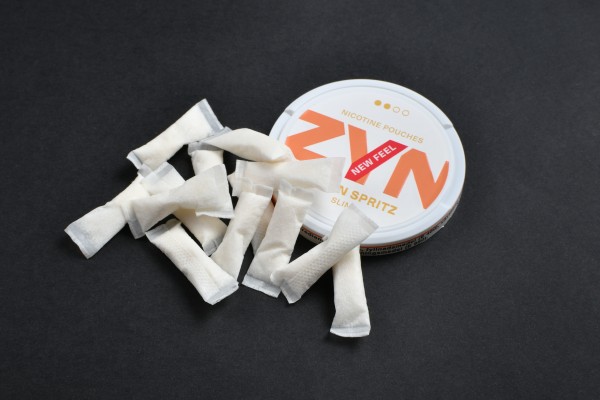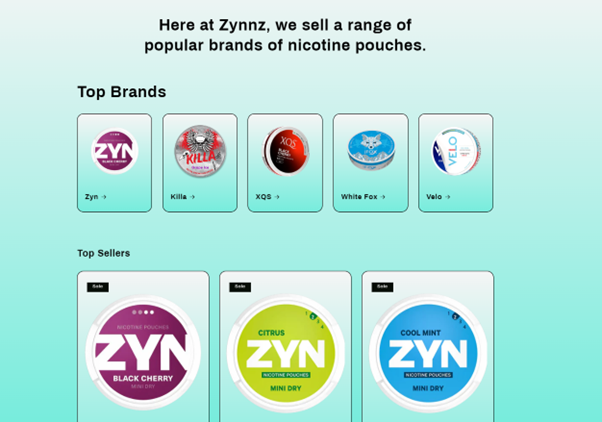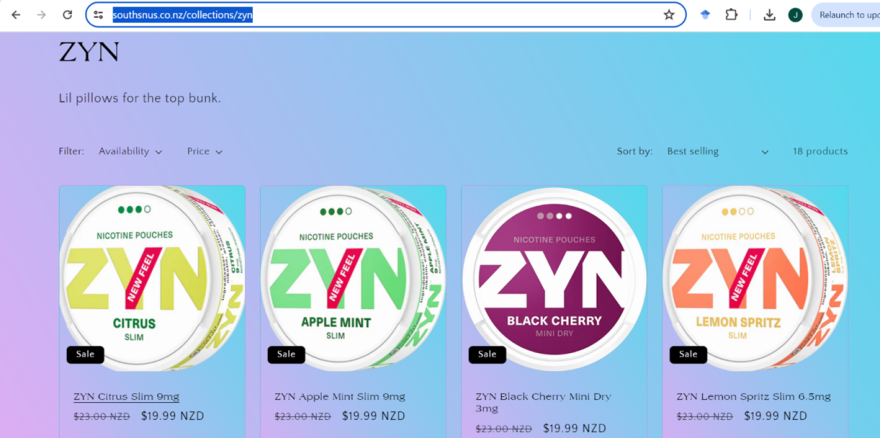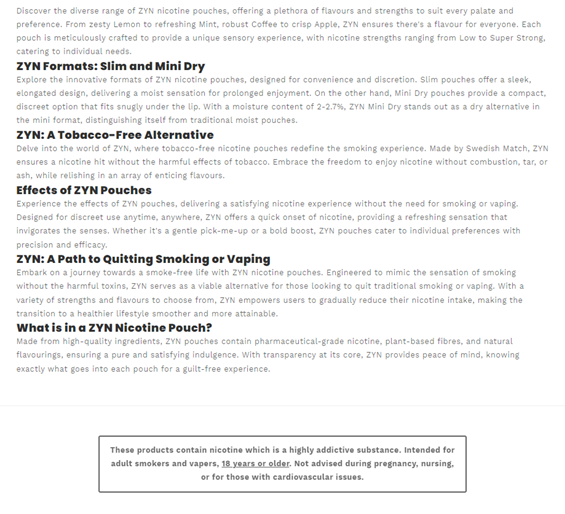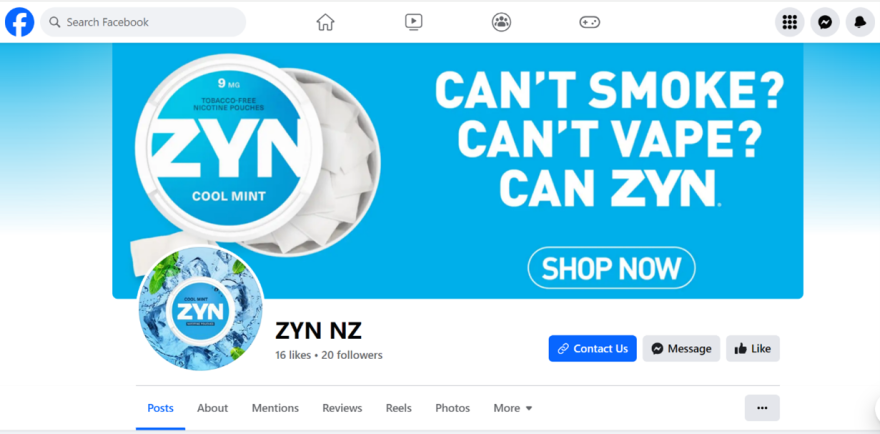Summary
Faced with declining use of their smoked tobacco products, tobacco companies have diversified their nicotine products to include e-cigarettes (ECs) heated tobacco products (e.g., IQOS) and, more recently, oral nicotine products (ONPs). Aotearoa New Zealand law currently disallows the sale of ONPs, although Associate Minister Casey Costello has proposed changing current policy. Nonetheless, ONPs are already widely promoted on social media and may be imported for personal use. In this Briefing, we examine how ONP marketing in Aotearoa has targeted young people, despite tobacco companies’ claim these products intend to offer people who smoke a new cessation option.
Marketers aim to integrate brands into people’s lifestyles and social identities. Tobacco companies promoted Virginia Slims to women by challenging masculine norms, while the Marlboro Man reassured men by entrenching those same norms.1,2 Industry marketers identified young people’s insecurities and aspirations, and positioned tobacco brands as familiar and reliable responses to these. As brand affiliations evolved, marketers embedded brands into social practices, for example, by creating connections between smoking and alcohol consumption.3,4
Legal rulings made it impossible for tobacco companies to continue denying the harms their products cause;5,6 they responded with a new narrative that claimed smoking’s harms were well known and that people made an “informed choice” to begin and continue smoking.5,7 Tobacco companies also repositioned themselves as the solution to problems caused by their smoked products;8 yet, as our earlier analysis explains, their motivations are profit driven not altruistic.
Recent product innovations include oral nicotine pouches products (ONPs), which users “park” on their upper gum. Nicotine is absorbed via oral mucosa rather than by inhalation of cigarette smoke or EC aerosol. Yet, although we lack robust evidence of ONPs’ safety and efficacy as stop smoking tools, tobacco companies promote ONPs for use in places where neither smoking nor ECs are permitted (see images 5-7).
Their “harm reduction” framing contrasts sharply with internal descriptions of these products as “additive”, which signals an intention to foster poly-tobacco or nicotine product use.9 That is, an “additive” strategy does not promote transition from one product to another but aims to increase overall market size by attracting new users to the products on offer.
Young people have long been the tobacco industry’s new users of choice because they offer more potential profit-years than other age groups.10 Tobacco companies in Aotearoa aggressively targeted their ECs at young people via music festivals, dance parties and sporting events,11,12 and their brands featured on social media platforms favoured by young people.13 Population surveys reveal rapidly rising EC use among young people who have never smoked (or never smoked regularly), with regulations doing little to change rising trends in experimentation, regular and daily use.
The successful marketing of ECs to young people, the population group where EC use prevalence is greatest, has informed ONP marketing.14 ONPs also have appealing flavours, come in attractive packages, feature youth-oriented brand names (e.g., ZYN, which has breed cult neologisms, such as ZYNfluencers), and the product positioning is as far removed from therapeutic smoking cessation aids as it is possible to imagine.15 Figure 1 and the Appendix illustrate these marketing strategies. Tobacco companies promote ONPs as “tobacco free”, which creates the impression these products are less addictive and less harmful than other nicotine products,16,17 and presents them as more discreet, convenient and “freeing” than ECs.17,18.
Although ONPs cannot legally be sold in Aotearoa New Zealand, NZ First has committed to reforming regulation of these products, and the Minister has already sought agreement in principle to their introduction. Tobacco companies, which lobbied to allow ONPs, are already promoting their products; for example, British American Tobacco New Zealand’s website explains ONPs, which it calls “modern oral products”, and introduces its brand. Other NZ websites openly advertise ONP sales (Figure 1); these websites included Zinger (dismantled late June, following a news story of a giveaway promotion). Zinger featured user testimonials and offered a price discount; ZYN NZ claims to be the original site selling ONPs in NZ and offers price discounts for volume purchases. Both sites have a “click box” age verification process to enter their websites, an ineffective measure to limit site access to people aged 18 or over.
Figure 1: Images sourced 23 June, 2024:
Previously available at: https://zingerpouches.co.nz/ and https://web.archive.org/web/20240622033333/https:/zyn-nz.com/
The evolution of social media platforms has seen new marketing strategies evolve. Social media posts on Tik Tok include paid influencer content as well as organic third-party content; unless influencers disclose their commercial links, viewers cannot identify the origin of posts.
Figure 2: Images sourced 23 June 2024
https://www.tiktok.com/@zynsforbreakfast/video/7347090771528486186?lang=en&q=ZYN&t=1719024904743
https://www.tiktok.com/@zynsforbreakfast/video/7348958981404233006?lang=en&q=ZYN&t=1719024904743
https://www.tiktok.com/@zynfluencer1/video/7307702791911345450
Influencers illustrate ONP use and position the products as desirable lifestyle accessories; organic content presents ONPs as solving challenges young people face (Figure 2). Collectively this marketing piques the interest of young people who have never used these products, thus stimulating market expansion.19
While tobacco companies may claim they cannot control organic social media promotions, they cannot evade responsibility for designing and marketing products that will appeal to youth or for spending millions of dollars on marketing via youth influencers.17
Tobacco companies persuaded regulators to view ECs as smoking cessation tools, then marketed these products to young people as lifestyle accessories.12,13 NZ, which now has one of the highest rates of youth EC use internationally, must learn from this experience, act urgently to control ONP marketing and enforce the law that disallows ONP sales in NZ. We also call for regulations that hold ONP manufacturers accountable for marketing that promotes their products, regardless of where that marketing originates. This protective approach could be liberalised if future independent research provided robust evidence of ONPs’ safety and efficacy as a tool to stop smoking, but should always recognise young people’s right to protection from the aggressive marketing that has already begun to target them.
What this Briefing adds
- Although oral nicotine products (ONPs) are not legally able to be sold in Aotearoa New Zealand, websites based in NZ advertise their availability.
- ONP marketing targets young people and uses similar strategies to those tobacco companies employed to market ECs, including influencer promotions, price promotions and loyalty programmes.
- Although ONPs’ efficacy and safety as a tool to help people stop smoking is unclear, sales of ONP products have risen rapidly internationally and use among young people who have not previously used nicotine products has also risen.
Implications for policy and practice
- Until there is robust, independent evidence that ONPs are an effective and safe method to help people stop smoking, there is no logical rationale for liberalising current NZ regulations.
- Regulators must enforce existing policies to prevent marketing and sales of ONPs to young people, monitor reported use among youth, and develop more protective measures, if monitoring shows increasing use among young people.
Authors details
Prof Janet Hoek, Co-Director of ASPIRE Aotearoa Research Centre, and Department of Public Health, University of Otago Wellington
Dr Jude Ball, ASPIRE Aotearoa Research Centre, and Department of Public Health, University of Otago Wellington
Dr Janine Nip, ASPIRE Aotearoa Research Centre, and Department of Public Health, University of Otago Wellington
Lani Teddy, Eru Pomare Centre, ASPIRE Aotearoa Research Centre, and Department of Public Health, University of Otago Wellington
Melissa-Jade Gregan, ASPIRE Aotearoa Research Centre, and Department of Public Health, University of Otago Wellington
Anna Graham-DeMello, ASPIRE Aotearoa Research Centre, and Department of Public Health, University of Otago Wellington
Dr Lucy Hardie, ASPIRE Aotearoa Research Centre, and Faculty of Medical and Health Sciences, University of Auckland
Associate Professor Jude McCool, ASPIRE Aotearoa Research Centre, and Faculty of Medical and Health Sciences, University of Auckland
Dr Michaela Pettie, ASPIRE Aotearoa Research Centre, and Department of Public Health, University of Otago Wellington
Appendix:
Screenshots from Oral Nicotine Pouch New Zealand websites
ONP marketing has stimulated considerable market growth. For example, in the third quarter of 2023, ZYN accounted for 76% of the US nicotine pouch market value and the Wall Street Journal reported that, within the US, Philip Morris International shipped over 130 million cans of ZYN in the first quarter of 2024, an increase of nearly 80% over the same period in 2023.
Image 1 illustrates varied oral nicotine product brands available and focuses on the ZYN flavours offered by ZYN NZ.
Source: Screenshot taken on 8 April 2024. The website was taken down later that day after being contacted by TVNZ Breakfast for comment, but reappeared soon after as www.pouches.co.nz.
Image 2 also emphasises the flavour range available at another website, SouthSnus.
Source: https://southsnus.co.nz/collections/zyn Screen shot taken on 24 June 2024.
Image 3, from website PouchMe, emphasises how ZYN enables users to navigate restrictions that might apply to smoking and ECs, and outlines how easily ZYN may be used.
Source: https://pouchme.co.nz/collections/zyn. Screenshot taken24 June 2024.
Image 4 promotes the freedom and convenience of using ZYN.
Source: ZYN NZ Facebook, screenshot taken 9 April 2024. After negative publicity on TVNZ’s Breakfast show, the Facebook page was renamed Pouches NZ and some of the content was changed or removed.
Images 5 to 7 are Instagram posts that promote freedom, health and convenience of ONPs.
Source: Snus.Aus.NZ Instagram account, screenshots 24 June 2024.
Images 8 and 9 are examples of social media posts featuring influencer “Daddy Wellness” (left) and right-wing political commentator Tucker Carlson (right), overlayed with messages emphasising ZYN’s availability in AoNZ.
Sources: Pouches NZ Facebook account, screenshots taken 24 June 2024.

